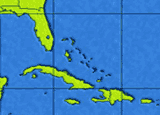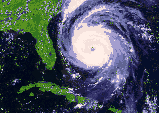|
Back to Florida Hurricane Main Page
Health Hazards Water
Contamination - Safety Tips
When a hurricane has left
an area there are a health hazards to watch out for. Illness lurks in the form of water
contamination.
Boiling water instructions are issued after a hurricane. That's usually because
the public water utility has lost pressure in its water moving systems, making it possible
for contaminants to enter water lines. Pay attention to local authorities on the status of
your water supply.
Use only bottled or disinfected water for drinking and cooking until the public water
supplies have been declared safe. The danger with tainted public supplies is from
bacterial contamination that can cause severe diarrhea. Untreated diarrhea can be life
threatening.
Water that you have saved in bottles before the storm should be good for up to six months,
if properly stored. Proper storage means leaving no air in the container and storing in
the dark. When in doubt, disinfect it.
Use disinfected or bottled water to brush your teeth and to give to pets.
To prevent the spread of disease, wash your hands frequently with disinfected water and
soap.
Don't use water that has a dark color, an odor or contains floating material.
Use water stored in the bathtub, from the pool or from the tap to flush the toilet. Don't
drink or cook with water from the pool.
Bathing or showering with tap water is fine, but don't let it get in your eyes ears or
mouth. If you shave with tap water, dab any cuts with antiseptic.
Only use bottled water for cleaning contact lenses.
Don't drink water from wells, especially in areas of sewage contamination.
You can avoid most health problems by disinfecting any tap water you use for cooking or
drinking. Always use clean containers.
Here's how to disinfect tap water: Boil at a rolling boil for at least 10
minutes. Let cool. Add a pinch of salt for taste. Pour the water back and forth between
clean containers to reduce the flat taste.
Liquid Chlorine: Normal household bleach can be used to kill germs in
water, but will not kill tuberculosis germs. Regular household bleach is a solution of
5.25% Sodium Hypochlorite and 94.75% inert ingredients. The bleach I want you to use
should be standard household bleach with no extra whiteners, brighteners, or scents of any
kind like lemon. Many manufactures bleach labels state "not fit for human
consumption", which is true (Does it need to be said? Ok, don't drink straight
bleach!) Now if the only active ingredient in your bleach is Sodium Hypochlorite, it is
suitable for water sterilization. Here's how you do it. Add 1/2 tsp. to 5 gallons of water
if it is clear (or 8 drops of chlorine bleach to each gallon of clear water) or 1 tsp. to
5 gallons of water if the water is cloudy. Allow your water to sit at least 30 minutes. If
water does not have a slight chlorine odor, repeat the dosage and let stand for 15
minutes. Now if you stock up on commercial sized coffee filters say from Sam's, you can
pre-filter your water. Be sure to sterilize and clean your water container, its lid,
spout, funnel after each use.
Powder Chlorine: You may be tempted to purchase a large quantity of
bleach for this purpose, but did you know that Chlorine gas would bleed through most
plastic bottles? Storing bleach in a warm place will speed up the gas leakage. So over
time your Chlorine concentration will diminish to a level you have no way of determining.
When this happens you will have no idea how much to put in the water, making this a shaky
situation. There is a way around this storage problem. You can make your own bleach by
purchasing swimming pool "burn out" or "shock treatment". It must be
only 65% Calcium Hypochlorite, no additional anti-fungal or clarifiers. In an extremely
well ventilated area thoroughly mix 24.5 grams, approximately 10 Tablespoons, of powder to
one gallon of water for a 5.25% bleach solution. Five pounds of dry pool bleach costs
about $10-15, which will make about 92 gallons of bleach, that will sterilize 706,560
gallons of clear water, or 353,280 gallons of cloudy water. If you allocate 3 gallons per
person per day for drinking, food preparation, and sanitation, $15 will take care of 100
people for one year! Not a bad deal.
Chlorine or Iodine Tablets
Follow directions on the package. If directions are not available, use 1 tablet for each
quart of water.
Make sure the tablet dissolves completely; mix thoroughly. Let stand for 30 minutes.
Liquid Iodine Add 5 drops of 2 percent iodine to each quart of clear
water. For cloudy water, add 10 drops of 2 percent iodine to each quart of water. Mix
thoroughly. Let stand for 30 minutes.
Until the danger of contamination has passed, don't drink or prepare any
food with tap water that hasn't been boiled. Don't let your pets drink tap water either.
They are no more immune than you are and in some cases they are at great risk. As for
brushing teeth, you'll need disinfected water. Don't wash your dishes with tap water
unless you are prepared to rinse them in extra-chlorinated water (15 drops of chlorine
bleach to the quart should do the trick.) Contact lens wearers should use disinfected
water to clean their hands before handling them. Washing them with tap water will lead to
eye infection.
Chemical Hazards
Be aware of potential chemical hazards
you may encounter in the aftermath of a storm, especially if the
hurricane is accompanied by flooding. Floodwaters and high winds
may have moved or buried hazardous chemical containers of
solvents or other industrial chemicals. Contact your local fire
department about inspecting and removing hazardous chemical
containers. Avoid inhaling any chemical vapors. Never "sniff"
any container to see if you can identify the contents, one sniff
of some chemicals and kill you grave yard dead.
Car batteries contain sulfuric acid, which is very caustic. Removal of automotive
batteries from your property can be accomplished safely, but they should be removed with
extreme caution. It is best to use "chemical" gloves and other safety equipment.
Avoid coming in contact with any acid that may have spilled from a damaged car battery.
Use baking soda to neutralize any acid spillage. |



